particular中文翻译
- 格式:doc
- 大小:52.50 KB
- 文档页数:11
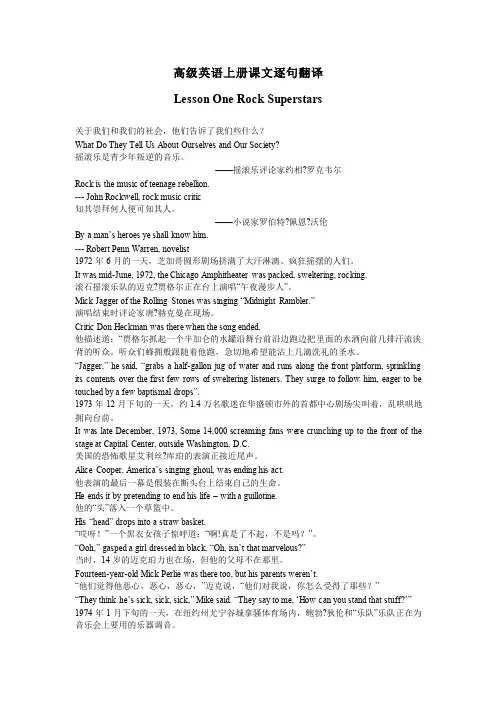
高级英语上册课文逐句翻译Lesson One Rock Superstars关于我们和我们的社会,他们告诉了我们些什么?What Do They Tell Us About Ourselves and Our Society?摇滚乐是青少年叛逆的音乐。
——摇滚乐评论家约相?罗克韦尔Rock is the music of teenage rebellion.--- John Rockwell, rock music critic知其崇拜何人便可知其人。
——小说家罗伯特?佩恩?沃伦By a man’s heroes ye shall know him.--- Robert Penn Warren, novelist1972年6月的一天,芝加哥圆形剧场挤满了大汗淋漓、疯狂摇摆的人们。
It was mid-June, 1972, the Chicago Amphitheater was packed, sweltering, rocking.滚石摇滚乐队的迈克?贾格尔正在台上演唱“午夜漫步人”。
Mick Jagger of the Rolling Stones was singing “Midnight Rambler.”演唱结束时评论家唐?赫克曼在现场。
Critic Don Heckman was there when the song ended.他描述道:“贾格尔抓起一个半加仑的水罐沿舞台前沿边跑边把里面的水洒向前几排汗流浃背的听众。
听众们蜂拥般跟随着他跑,急切地希望能沾上几滴洗礼的圣水。
“Jagger,” he said, “grabs a half-gallon jug of water and runs along the front platform, sprinkling its contents over the first few rows of sweltering listeners. They surge to follow him, eager to be touched by a few baptismal drops”.1973年12月下旬的一天,约1.4万名歌迷在华盛顿市外的首都中心剧场尖叫着,乱哄哄地拥向台前。
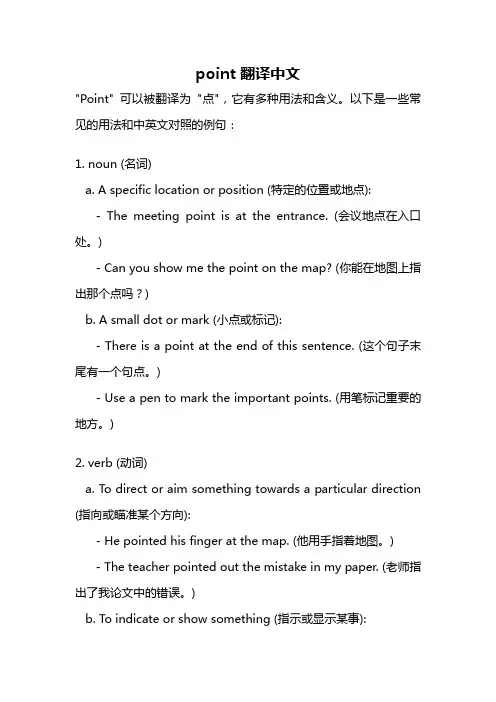
point 翻译中文"Point" 可以被翻译为"点",它有多种用法和含义。
以下是一些常见的用法和中英文对照的例句:1. noun (名词)a. A specific location or position (特定的位置或地点):- The meeting point is at the entrance. (会议地点在入口处。
)- Can you show me the point on the map? (你能在地图上指出那个点吗?)b. A small dot or mark (小点或标记):- There is a point at the end of this sentence. (这个句子末尾有一个句点。
)- Use a pen to mark the important points. (用笔标记重要的地方。
)2. verb (动词)a. To direct or aim something towards a particular direction (指向或瞄准某个方向):- He pointed his finger at the map. (他用手指着地图。
)- The teacher pointed out the mistake in my paper. (老师指出了我论文中的错误。
)b. To indicate or show something (指示或显示某事):- The sign pointed to the nearest exit. (指示牌指向最近的出口。
)- The compass needle is pointing north. (指南针指向北方。
)3. adjective (形容词)a. Having a sharp or tapered end (尖的或锐利的):- Be careful with that knife; it has a sharp point. (小心那把刀,它有个尖锐的刀尖。
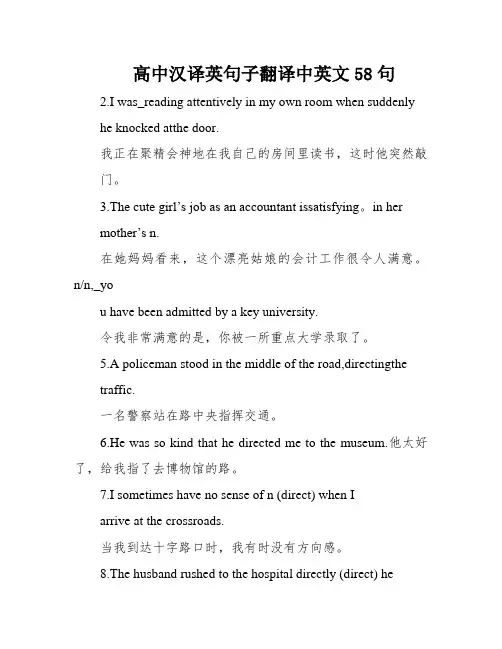
高中汉译英句子翻译中英文58句2.I was_reading attentively in my own room when suddenlyhe knocked atthe door.我正在聚精会神地在我自己的房间里读书,这时他突然敲门。
3.The cute girl’s job as an accountant issatisfying。
in hermother’s n.在她妈妈看来,这个漂亮姑娘的会计工作很令人满意。
n/n,_you have been admitted by a key university.令我非常满意的是,你被一所重点大学录取了。
5.A policeman stood in the middle of the road,directingthetraffic.一名警察站在路中央指挥交通。
6.He was so kind that he directed me to the museum.他太好了,给我指了去博物馆的路。
7.I sometimes have no sense of n (direct) when Iarrive at the crossroads.当我到达十字路口时,我有时没有方向感。
8.The husband rushed to the hospital directly (direct) heheard that his wife was injured.丈夫一听到他的妻子受伤了就匆忙赶往医院。
9.Her husband was always there and she justtookhimforgranted.她丈夫随时都在身旁,她只是以为他理应云云。
10.Chatting on the。
mayhave a bad effect onyourstudy.网上谈天大概会对你的进修发生不良影响。
11.It’s said that the son will take over the company afterthe father’s retirement.据说(那位)父亲退休以后将由儿子接管公司。

和打电话相关词汇中英文翻译和打电话相关词汇中英文翻译“打电话”相关用语Phone books have white, blue and yellow pages.The white pages list people with phones by last name.The blue pages contain numbers of city services, government services and public services. Businesses and professional services are listed in a special classified directory-the Yellow Pages.It is generally very easy to find a public telephonein the developed countries. Public phones are located in bus and railroad stations, airports, stores, hotels, restaurants, gasoline stations, on numerous street corners and in most office buildings. From a corner pay-call, you pick up the phone, listen for a dial tone (a buzzing sound), deposits a coin or coins (depending on the cost in the area) and then dial the number.A person-to-person call can only be accepted by the particular person you are calling. Thus, if that personis not there, you will not be charged. However,person-to-person and collect calls are more expensive than calls dialed directly because they involve the additional labor cost of an operator. The person being called pays for a " collect" call rather than by theperson making the call. If you make a long distance call and get a wrong number, call the operator and explain what happened. This means that you can make the call again to the right number without having to pay more money; or you can have the phone company mail you acredit coupon that has the same value as the phone call.电话电话簿有白页、蓝页和黄页。
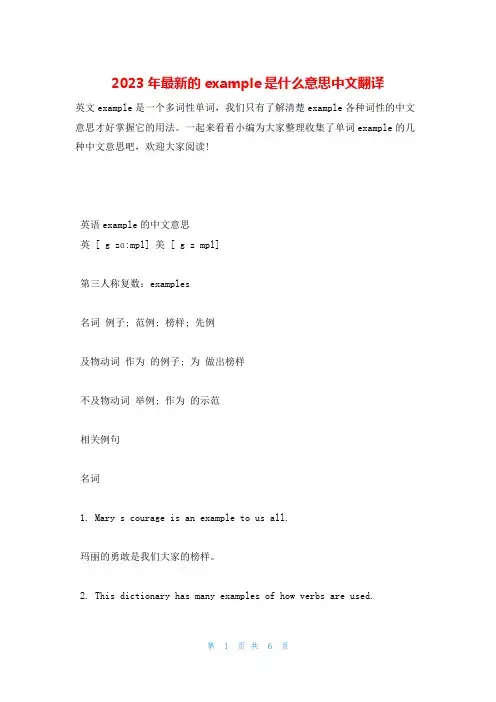
2023年最新的example是什么意思中文翻译英文example是一个多词性单词,我们只有了解清楚example各种词性的中文意思才好掌握它的用法。
一起来看看小编为大家整理收集了单词example的几种中文意思吧,欢迎大家阅读!英语example的中文意思英 [ g zɑ:mpl] 美 [ g z mpl]第三人称复数:examples名词例子; 范例; 榜样; 先例及物动词作为的例子; 为做出榜样不及物动词举例; 作为的示范相关例句名词1. Mary s courage is an example to us all.玛丽的勇敢是我们大家的榜样。
2. This dictionary has many examples of how verbs are used.这本词典有许多关于动词用法的例句。
3. Their courage was an example to all of us.他们的勇气是我们大家学习的榜样。
4. Please give an example.请举一个例子。
单词example的词典解释1. 例子;例证;实例An example of something is a particular situation, object, or person which shows that what is being claimed is true.e.g. The doctors gave numerous examples of patients being expelled from hospital...医生们列举了大量病人被逐出医院的实例。
e.g. Listed below are just a few examples of some of the family benefits available.下面仅例举了家庭可享受的几种福利。
2. 范例;样本;代表An example of a particular class of objects or styles is something that has many of the typical features of such a class or style, and that you consider clearly represents it.e.g. Symphonies 103 and 104 stand as perfect examples of early symphonic construction...第103和104号交响曲是早期交响乐结构的典型代表。
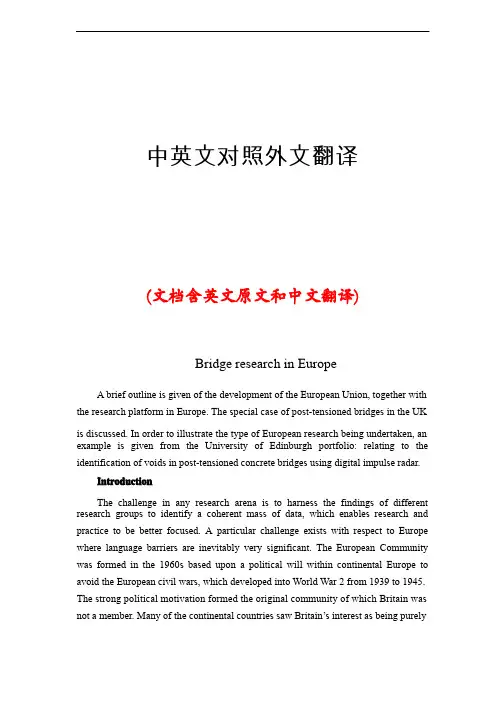
中英文对照外文翻译(文档含英文原文和中文翻译)Bridge research in EuropeA brief outline is given of the development of the European Union, together withthe research platform in Europe. The special case of post-tensioned bridges in the UK is discussed. In order to illustrate the type of European research being undertaken, an example is given from the University of Edinburgh portfolio: relating to the identification of voids in post-tensioned concrete bridges using digital impulse radar.IntroductionThe challenge in any research arena is to harness the findings of different research groups to identify a coherent mass of data, which enables research and practice to be better focused. A particular challenge exists with respect to Europe where language barriers are inevitably very significant. The European Community was formed in the 1960s based upon a political will within continental Europe to avoid the European civil wars, which developed into World War 2 from 1939 to 1945. The strong political motivation formed the original community of which Britain was not a member. Many of the continental countries saw Britain’s interest as being purelyeconomic. The 1970s saw Britain joining what was then the European Economic Community (EEC) and the 1990s has seen the widening of the community to a European Union, EU, with certain political goals together with the objective of a common European currency.Notwithstanding these financial and political developments, civil engineering and bridge engineering in particular have found great difficulty in forming any kind of common thread. Indeed the educational systems for University training are quite different between Britain and the European continental countries. The formation of the EU funding schemes —e.g. Socrates, Brite Euram and other programs have helped significantly. The Socrates scheme is based upon the exchange of students between Universities in different member states. The Brite Euram scheme has involved technical research grants given to consortia of academics and industrial partners within a number of the states—— a Brite Euram bid would normally be led by partners within a number of the statesan industrialist.In terms of dissemination of knowledge, two quite different strands appear to have emerged. The UK and the USA have concentrated primarily upon disseminating basic research in refereed journal publications: ASCE, ICE and other journals. Whereas the continental Europeans have frequently disseminated basic research at conferences where the circulation of the proceedings is restricted.Additionally, language barriers have proved to be very difficult to break down. In countries where English is a strong second language there has been enthusiastic participation in international conferences based within continental Europe —e.g. Germany, Italy, Belgium, The Netherlands and Switzerland. However, countries where English is not a strong second language have been hesitant participants }—e.g. France.European researchExamples of research relating to bridges in Europe can be divided into three types of structure:Masonry arch bridgesBritain has the largest stock of masonry arch bridges. In certain regions of the UK up to 60% of the road bridges are historic stone masonry arch bridges originally constructed for horse drawn traffic. This is less common in other parts of Europe as many of these bridges were destroyed during World War 2.Concrete bridgesA large stock of concrete bridges was constructed during the 1950s, 1960s and 1970s. At the time, these structures were seen as maintenance free. Europe also has a large number of post-tensioned concrete bridges with steel tendon ducts preventing radar inspection. This is a particular problem in France and the UK.Steel bridgesSteel bridges went out of fashion in the UK due to their need for maintenance as perceived in the 1960s and 1970s. However, they have been used for long span and rail bridges, and they are now returning to fashion for motorway widening schemes in the UK.Research activity in EuropeIt gives an indication certain areas of expertise and work being undertaken in Europe, but is by no means exhaustive.In order to illustrate the type of European research being undertaken, an example is given from the University of Edinburgh portfolio. The example relates to the identification of voids in post-tensioned concrete bridges, using digital impulse radar.Post-tensioned concrete rail bridge analysisOve Arup and Partners carried out an inspection and assessment of the superstructure of a 160 m long post-tensioned, segmental railway bridge in Manchester to determine its load-carrying capacity prior to a transfer of ownership, for use in the Metrolink light rail system..Particular attention was paid to the integrity of its post-tensioned steel elements.Physical inspection, non-destructive radar testing and other exploratory methods were used to investigate for possible weaknesses in the bridge.Since the sudden collapse of Ynys-y-Gwas Bridge in Wales, UK in 1985, there has been concern about the long-term integrity of segmental, post-tensioned concrete bridges which may b e prone to ‘brittle’ failure without warning. The corrosion protection of the post-tensioned steel cables, where they pass through joints between the segments, has been identified as a major factor affecting the long-term durability and consequent strength of this type of bridge. The identification of voids in grouted tendon ducts at vulnerable positions is recognized as an important step in the detection of such corrosion.Description of bridgeGeneral arrangementBesses o’ th’ Barn Bridge is a 160 m long, three span, segmental, post-tensionedconcrete railway bridge built in 1969. The main span of 90 m crosses over both the M62 motorway and A665 Bury to Prestwick Road. Minimum headroom is 5.18 m from the A665 and the M62 is cleared by approx 12.5 m.The superstructure consists of a central hollow trapezoidal concrete box section 6.7 m high and 4 m wide. The majority of the south and central spans are constructed using 1.27 m long pre-cast concrete trapezoidal box units, post-tensioned together. This box section supports the in site concrete transverse cantilever slabs at bottom flange level, which carry the rail tracks and ballast.The center and south span sections are of post-tensioned construction. These post-tensioned sections have five types of pre-stressing:1. Longitudinal tendons in grouted ducts within the top and bottom flanges.2. Longitudinal internal draped tendons located alongside the webs. These are deflected at internal diaphragm positions and are encased in in site concrete.3. Longitudinal macalloy bars in the transverse cantilever slabs in the central span .4. Vertical macalloy bars in the 229 mm wide webs to enhance shear capacity.5. Transverse macalloy bars through the bottom flange to support the transverse cantilever slabs.Segmental constructionThe pre-cast segmental system of construction used for the south and center span sections was an alternative method proposed by the contractor. Current thinkingire suggests that such a form of construction can lead to ‘brittle’ failure of the ententire structure without warning due to corrosion of tendons across a construction joint,The original design concept had been for in site concrete construction.Inspection and assessmentInspectionInspection work was undertaken in a number of phases and was linked with the testing required for the structure. The initial inspections recorded a number of visible problems including:Defective waterproofing on the exposed surface of the top flange.Water trapped in the internal space of the hollow box with depths up to 300 mm.Various drainage problems at joints and abutments.Longitudinal cracking of the exposed soffit of the central span.Longitudinal cracking on sides of the top flange of the pre-stressed sections.Widespread sapling on some in site concrete surfaces with exposed rusting reinforcement.AssessmentThe subject of an earlier paper, the objectives of the assessment were:Estimate the present load-carrying capacity.Identify any structural deficiencies in the original design.Determine reasons for existing problems identified by the inspection.Conclusion to the inspection and assessmentFollowing the inspection and the analytical assessment one major element of doubt still existed. This concerned the condition of the embedded pre-stressing wires, strands, cables or bars. For the purpose of structural analysis these elements、had been assumed to be sound. However, due to the very high forces involved,、a risk to the structure, caused by corrosion to these primary elements, was identified.The initial recommendations which completed the first phase of the assessment were:1. Carry out detailed material testing to determine the condition of hidden structural elements, in particularthe grouted post-tensioned steel cables.2. Conduct concrete durability tests.3. Undertake repairs to defective waterproofing and surface defects in concrete.Testing proceduresNon-destructi v e radar testingDuring the first phase investigation at a joint between pre-cast deck segments the observation of a void in a post-tensioned cable duct gave rise to serious concern about corrosion and the integrity of the pre-stress. However, the extent of this problem was extremely difficult to determine. The bridge contains 93 joints with an average of 24 cables passing through each joint, i.e. there were approx. 2200 positions where investigations could be carried out. A typical section through such a joint is that the 24 draped tendons within the spine did not give rise to concern because these were protected by in site concrete poured without joints after the cables had been stressed.As it was clearly impractical to consider physically exposing all tendon/joint intersections, radar was used to investigate a large numbers of tendons and hence locate duct voids within a modest timescale. It was fortunate that the corrugated steel ducts around the tendons were discontinuous through the joints which allowed theradar to detect the tendons and voids. The problem, however, was still highly complex due to the high density of other steel elements which could interfere with the radar signals and the fact that the area of interest was at most 102 mm wide and embedded between 150 mm and 800 mm deep in thick concrete slabs.Trial radar investigations.Three companies were invited to visit the bridge and conduct a trial investigation. One company decided not to proceed. The remaining two were given 2 weeks to mobilize, test and report. Their results were then compared with physical explorations.To make the comparisons, observation holes were drilled vertically downwards into the ducts at a selection of 10 locations which included several where voids were predicted and several where the ducts were predicted to be fully grouted. A 25-mm diameter hole was required in order to facilitate use of the chosen horoscope. The results from the University of Edinburgh yielded an accuracy of around 60%.Main radar sur v ey, horoscope verification of v oids.Having completed a radar survey of the total structure, a baroscopic was then used to investigate all predicted voids and in more than 60% of cases this gave a clear confirmation of the radar findings. In several other cases some evidence of honeycombing in the in site stitch concrete above the duct was found.When viewing voids through the baroscopic, however, it proved impossible to determine their actual size or how far they extended along the tendon ducts although they only appeared to occupy less than the top 25% of the duct diameter. Most of these voids, in fact, were smaller than the diameter of the flexible baroscopic being used (approximately 9 mm) and were seen between the horizontal top surface of the grout and the curved upper limit of the duct. In a very few cases the tops of the pre-stressing strands were visible above the grout but no sign of any trapped water was seen. It was not possible, using the baroscopic, to see whether those cables were corroded.Digital radar testingThe test method involved exciting the joints using radio frequency radar antenna: 1 GHz, 900 MHz and 500 MHz. The highest frequency gives the highest resolution but has shallow depth penetration in the concrete. The lowest frequency gives the greatest depth penetration but yields lower resolution.The data collected on the radar sweeps were recorded on a GSSI SIR System 10.This system involves radar pulsing and recording. The data from the antenna is transformed from an analogue signal to a digital signal using a 16-bit analogue digital converter giving a very high resolution for subsequent data processing. The data is displayed on site on a high-resolution color monitor. Following visual inspection it isthen stored digitally on a 2.3-gigabyte tape for subsequent analysis and signal processing. The tape first of all records a ‘header’ noting the digital radar settings together with the trace number prior to recording the actual data. When the data is played back, one is able to clearly identify all the relevant settings —making for accurate and reliable data reproduction.At particular locations along the traces, the trace was marked using a marker switch on the recording unit or the antenna.All the digital records were subsequently downloaded at the University’s NDT laboratory on to a micro-computer.(The raw data prior to processing consumed 35 megabytes of digital data.) Post-processing was undertaken using sophisticated signal processing software. Techniques available for the analysis include changing the color transform and changing the scales from linear to a skewed distribution in order to highlight、突出certain features. Also, the color transforms could be changed to highlight phase changes. In addition to these color transform facilities, sophisticated horizontal and vertical filtering procedures are available. Using a large screen monitor it is possible to display in split screens the raw data and the transformed processed data. Thus one is able to get an accurate indication of the processing which has taken place. The computer screen displays the time domain calibrations of the reflected signals on the vertical axis.A further facility of the software was the ability to display the individual radar pulses as time domain wiggle plots. This was a particularly valuable feature when looking at individual records in the vicinity of the tendons.Interpretation of findingsA full analysis of findings is given elsewhere, Essentially the digitized radar plots were transformed to color line scans and where double phase shifts were identified in the joints, then voiding was diagnosed.Conclusions1. An outline of the bridge research platform in Europe is given.2. The use of impulse radar has contributed considerably to the level of confidence in the assessment of the Besses o’ th’ Barn Rail Bridge.3. The radar investigations revealed extensive voiding within the post-tensioned cable ducts. However, no sign of corrosion on the stressing wires had been foundexcept for the very first investigation.欧洲桥梁研究欧洲联盟共同的研究平台诞生于欧洲联盟。
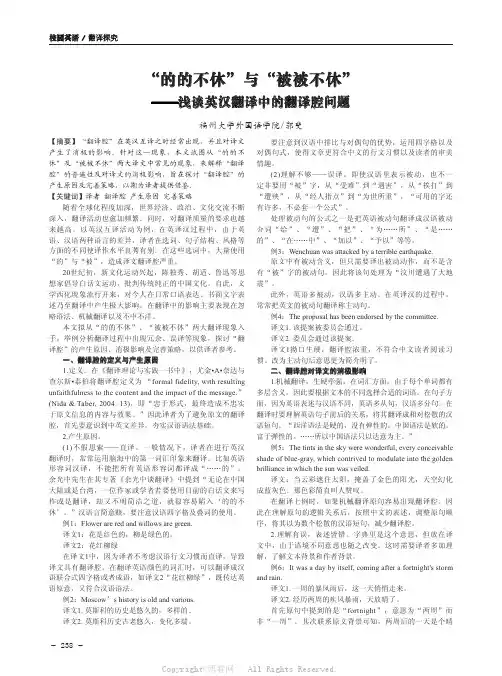
- 238-校园英语 / 翻译探究“的的不休”与“被被不休”——浅谈英汉翻译中的翻译腔问题福州大学外国语学院/郭斐【摘要】“翻译腔”在英汉互译之时经常出现,并且对译文产生了消极的影响。
针对这一现象,本文试图从“的的不休”及“被被不休”两大译文中常见的现象,来解释“翻译腔”的普遍性及对译文的消极影响,旨在探讨“翻译腔”的产生原因及完善策略,以期为译者提供借鉴。
【关键词】译者 翻译腔 产生原因 完善策略随着全球化程度加深,世界经济、政治、文化交流不断深入,翻译活动也愈加频繁。
同时,对翻译质量的要求也越来越高。
以英汉互译活动为例,在英译汉过程中,由于英语、汉语两种语言的差异,译者在选词、句子结构、风格等方面的不同使译作水平良莠有别。
在这些选词中,大量使用“的”与“被”,造成译文翻译腔严重。
20世纪初,新文化运动兴起,陈独秀、胡适、鲁迅等思想家倡导白话文运动,批判传统纯正的中国文化。
自此,文学西化现象流行开来,对今人在日常口语表达、书面文字表述乃至翻译中产生极大影响。
在翻译中的影响主要表现在忽略语法、机械翻译以及不中不洋。
本文拟从“的的不休”、“被被不休”两大翻译现象入手,举例分析翻译过程中出现冗余、误译等现象,探讨“翻译腔”的产生原因、消极影响及完善策略,以供译者参考。
一、翻译腔的定义与产生原因1.定义。
在《翻译理论与实践一书中》,尤金•A•奈达与查尔斯•泰伯将翻译腔定义为 “formal fidelity, with resulting unfaithfulness to the content and the impact of the message.” (Nida & Taber, 2004: 13),即“忠于形式,最终造成不忠实于原文信息的内容与效果。
”因此译者为了避免原文的翻译腔,首先要意识到中英文差异,夯实汉语语法基础。
2.产生原因。
(1)不假思索——直译。
一般情况下,译者在进行英汉翻译时,常常运用脑海中的第一词汇印象来翻译。
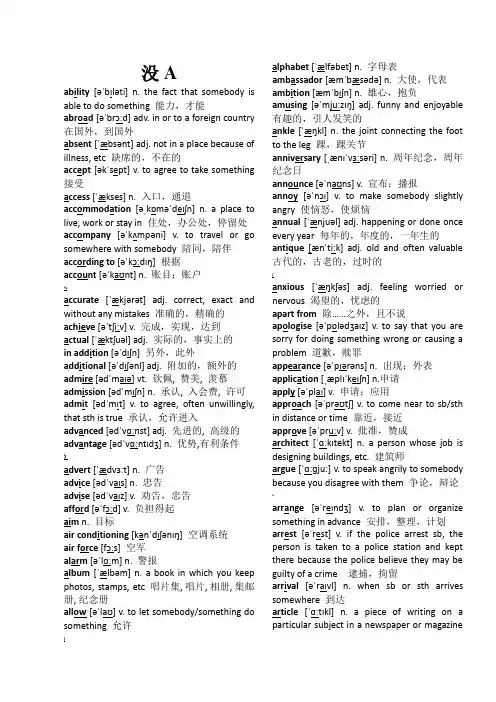
没Aability[əˈbɪləti] n. the fact that somebody is able to do something 能力,才能abroad [əˈbrɔːd] adv. in or to a foreign country 在国外,到国外absent[ˈæbsənt] adj. not in a place because of illness, etc 缺席的,不在的accept [əkˈs ept] v. to agree to take something 接受access [ˈækses] n. 入口,通道accommodation [əˌkɒməˈdeɪʃn] n. a place to live, work or stay in 住处,办公处,停留处accompany[əˈkʌmpəni] v. to travel or go somewhere with somebody 陪同,陪伴according to [əˈkɔːdɪŋ] 根据account [əˈkaʊnt] n. 账目;账户%accurate [ˈækjərət] adj. correct, exact and without any mistakes 准确的,精确的achieve [əˈtʃiːv] v. 完成,实现,达到actual [ˈæktʃuəl] adj. 实际的,事实上的in addition [əˈdɪʃn] 另外,此外additional [əˈdɪʃənl] adj. 附加的,额外的admire [ədˈm aɪə] vt. 钦佩, 赞美, 羡慕admission [ədˈmɪʃn] n. 承认, 入会费, 许可admit[ədˈmɪt] v. to agree, often unwillingly, that sth is true 承认,允许进入advanced [ədˈvɑːnst] adj. 先进的, 高级的advantage [ədˈvɑːntɪdʒ] n. 优势,有利条件)advert [ˈædvɜːt] n. 广告advice [ədˈv aɪs] n. 忠告advise [ədˈv aɪz] v. 劝告,忠告afford [əˈfɔːd] v. 负担得起aim n. 目标air conditioning [kənˈdɪʃənɪŋ] 空调系统air force [fɔːs] 空军alarm [əˈlɑːm] n. 警报album[ˈælbəm] n. a book in which you keep photos, stamps, etc 唱片集, 唱片, 相册, 集邮册, 纪念册allow [əˈlaʊ] v. to let somebody/something do something 允许{alphabet [ˈælfəbet] n. 字母表ambassador [æmˈbæsədə] n. 大使,代表ambition [æmˈbɪʃn] n. 雄心,抱负amusing[əˈm juːzɪŋ] adj. funny and enjoyable 有趣的,引人发笑的ankle[ˈæŋkl] n. the joint connecting the foot to the leg 踝,踝关节anniversary [ˌænɪˈvɜːsəri] n. 周年纪念,周年纪念日announce [əˈnaʊns] v. 宣布;播报annoy[əˈnɔɪ] v. to make somebody slightly angry 使恼怒,使烦恼annual [ˈænjuəl] adj. happening or done once every year 每年的,年度的,一年生的antique[ænˈtiːk] adj. old and often valuable 古代的,古老的,过时的(anxious[ˈæŋkʃəs] adj. feeling worried or nervous 渴望的,忧虑的apart from除……之外,且不说apologise[əˈpɒlədʒaɪz] v. to say that you are sorry for doing something wrong or causing a problem 道歉,赎罪appearance [əˈpɪərəns] n. 出现;外表application [ˌæplɪˈkeɪʃn] n.申请apply [əˈplaɪ] v. 申请;应用approach [əˈprəʊtʃ] v. to come near to sb/sth in distance or time 靠近,接近approve [əˈpr uːv] v. 批准,赞成architect [ˈɑːkɪtekt] n. a person whose job is designing buildings, etc. 建筑师argue [ˈɑːɡjuː] v. to speak angrily to somebody because you disagree with them 争论,辩论^arrange[əˈreɪndʒ] v. to plan or organize something in advance 安排,整理,计划arrest[əˈrest] v. if the police arrest sb, the person is taken to a police station and kept there because the police believe they may be guilty of a crime 逮捕,拘留arrival [əˈraɪvl] n. when sb or sth arrives somewhere 到达article [ˈɑːtɪkl] n. a piece of writing on a particular subject in a newspaper or magazine文章at present现在,目前(now)athlete [ˈæθliːt] n. a person who is very good at sports or physical exercise, especially one who competes in organized events 运动员athletics [æθˈl etɪks] n. 体育运动,田径atmosphere [ˈætməsfɪə] n.气氛;大气,空气attach [əˈtætʃ] v. 附上,系上attack [əˈtæk] v. 攻击,侵袭【attempt [əˈtempt] n.&v. 企图,尝试attend [əˈtend] v. 出席,参加attitude [ˈætɪtjuːd] n. 态度,看法attract [əˈtrækt] v. 吸引audience[ˈɔːdiəns] n. the group of people together in one place to watch or listen to a play, film, someone speaking, etc. 听众,观众,读者automatically [ˌɔːtəˈmætɪkli] adv. 自动地,机械地available [əˈveɪləbl] adj. 有效的,可用的,可得到的average [ˈævərɪdʒ] adj. 平均的,一般的,通常的avoid [əˈvɔɪd] v. 避免】Bbackground['bækɡr aund] n. the details of a person's family, education, experience, etc背景, 经历, 幕后, 后景backpack[ˈbækpæk] n. a large bag, often supported on a light metal frame, carried on the back and used especially by people who go climbing or walking 背包backwards [ˈbækwədz] adj. towards a place or position that is behind落后的, 向后的baggage [ˈ'bægidʒ] n. = luggage 行李balance[ˈbæləns] n. a situation in which different things exist in equal, correct or good amounts 平衡balcony[ˈbælkəni] n. a platform that is built on the upstairs outside wall of a building, with a wall or rail around it. You can get out onto a balcony from an upstairs room. 阳台:bald [bɔːld] adj. having little or no hair on the head秃头的ballet [ˈbælei] n. a style of dancing that tells a dramatic story with music but no talking or singing 芭蕾舞bandage[ˈbændidʒ] n. a strip of cloth used for tying around a part of the body that has been hurt in order to protect or support it 绷带bank balance: he amount of money that somebody has in their bank account at a particular time 银行存款, 银行余额banknote[ˈbæŋknəʊt] n. a piece of printed paper that has a particular value as money钞票barbecue[ˈbɑːbi kjuː] n. an outdoor meal or party when food is cooked in this way烤肉, 烧烤, 烤架bare[beə(r)] adj. not covered with or protected by anything 赤裸的,仅有的baseball [ˈbeisbɔ:l] n. a game played especially in the US by two teams of nine players, using a bat and ball. Each player tries to hit the ball and then run around four bases before the other team can return the ball 棒球basement [ˈbeismənt] n. a room or rooms in a building, partly or completely below the level of the ground 地下室basic [ˈbeisik] 基础的,bat[bæt] n. a piece of wood with a handle, made in various shapes and sizes, and used for hitting the ball in games such as baseball, cricket and table tennis 球棒,球拍battle [ˈbætl] n. a fight between armies, ships or planes, especially during a war; a violent fight between groups of people 战役bay [bei] n. a part of the sea, or of a large lake, partly surrounded by a wide curve of the land海湾beard [biəd] n. hair that grows on the chin and cheeks of a man's face; similar hair that grows on some animals 胡须beat [b iːt] v. to hit somebody/something many times, usually very hard/to defeat somebody in a game or competition 敲打;打败behave [biˈheiv] v. 表现believe[biˈliːv]v. to feel certain that something is true or that somebody is telling you the truth 相信belong [bi'l ɔŋ] v. to be in the right or suitable place 应归入;属于belongings[bi'lɔ:ŋiŋz] n. the things that a person owns, especially those which can be carried 财产;所有物beneath[bi'ni:θ] prep. in or to a lower position than, under 在……之下【benefit [ˈbenifit] n. 利益;好处beyond [biˈj ɔnd] prep. more than something; used to say that something is not possible 超出;远于;除…..之外biography[baiˈɔɡrəfi] n.the story of a person's life written by somebody else; this type of writing 传记biology[baiˈɔlədʒi] n. the scientific study of the life and structure of plants and animals 生物学bitter[ˈbitə(r)] adj. angry; very unpleasant taste; very cold 苦的;痛苦的;心酸的blame[bleim] v. to think or say that somebody/something is responsible for something bad 责备blanket [ˈblæŋk it] n. a large cover, often made of wool, used especially on beds to keep people warm 毛毯bleed [bl iːd] v. 流血block[blɔk] n. 块,片(木、石等)、大厦、街区board [bɔːd] n. 木板v. 登机*boarding pass登机牌bold [bəʊld] adj. brave; not fearing danger 大胆的boarder [ˈbɔːdə] n. at a school who sleeps and eats there and only goes home during school holidays 寄宿者brake [breik] n. device for slowing or stopping a vehicle 刹车;闸;制动器branch [brɑːntʃ] n. a part of a tree that grows out from the main stem and on which leaves, flowers and fruit grow 树枝;分支break down出故障break in闯入break up解散breath [breθ] n. the air that you take into your lungs and send out again 呼吸brick [brik] n. 砖;Ccloth [klɔθ]n. (a type of) woven material 布, 布料, 一块布collar ['kɔlə] n. the part around the neck of a piece of clothing 衣领cotton ['kɔtn] n. 棉花, 棉制品, 棉布calculator [ˈkælkjuleɪtə(r] n.计算器connect[kə'nekt] v. to join or be joined with something else 连接, 接通,$certificate [ səˈtɪfɪkət] n.执照, 证(明)书chemistry [ ˈkemɪstri] n.化学college[ ˈkɒlɪdʒ] n.学院composition[ ˌkɒmpəˈzɪʃn] n. the act of creating written works 作文,corridor[ ˈkɒrɪdɔː(r)] n. an enclosed passageway 走廊curriculum [kəˈrɪkjələm] n. the subjects that are included in a course of study or taught in a school, 全部课程,cassette [kəˈset] n. 盒式磁带channel [ˈtʃænl] n. on television / radio频道, circus [ˈsɜːkəs] n.马戏团, 马戏表演, 竞技场,广场comedy [ˈkɒmədi] n. a play or film/movie that is intended to be funny, usually with a happy ending; 喜剧, 滑稽,》comedian [kəˈmiːdiən] n. an entertainer who makes people laugh by telling jokes or funny stories 喜剧演员comic [ˈkɒmɪk] n. 连环图画, 喜剧演员commercial [kəˈmɜːʃl] adj. connected with the buying and selling of goods 商业的concert [ˈkɒnsət] n. 音乐会costume [ˈkɒstjuːm] n. 服装, 剧装climate [ˈklaɪmət] n. 气候canteen [kænˈtiːn] n. a place where food and drink are served in a factory, a school, etc. 食堂,cauliflower [ˈkɒliflaʊə(r)] n..花椰菜celery [ˈseləri] n.芹菜cocoa [ˈkəʊkəʊ] n. 可可粉, 可可饮料, 可可色!curry [ˈkʌri] n. 咖哩饭菜, 咖哩粉chemist [ˈkemɪst] n. 化学家, 药剂师campsite [ˈkæmpsaɪt] n. 露营地chess [tʃes] n.国际象棋collector [kəˈlektə(r)] n. a person who collects things, either as a hobby, or as a job: an art / a stamp collector ◆ticket / tax / debt collectors收集家, 收税员cruise [kruːz] n. a journey by sea, visiting different place 巡航, 漫游ceiling [ˈsiːlɪŋ] n.天花板;cellar [ˈselə(r)] n. an underground room often used for storing things 地窖, 地下室central heating [ˈsentrəl] n. a system for heating a building from one source which then pumps the hot water or hot air through pipes all around the building中央暖气系统cloakroom [ˈkləʊkruːm] n. (剧场等)衣帽间, (车站等)行李站暂存处,?cottage [ˈkɒtɪdʒ] n.小屋,村舍curtain [ˈkɜːtn] n. 帘;窗帘;门帘;帷幔cushion [ˈkʊʃn] n. 垫子;坐垫;靠垫chat/ tʃæt / v. to talk to someone in a friendly informal way闲谈, 谈天communicate / kəˈmjuːnɪkeɪt / v. to talk about your thoughts and feelings, and help other people to understand them传达, 沟通, 交流communication/ kəˌmjuːnɪˈkeɪʃn / n. 交流, 通讯, 传达, 通信, 沟通calm/ kɑːm/adj. peaceful and quiet; 平静的, 冷静的challenging/ ˈtʃælɪndʒɪŋ/ adj. difficult, in a way that tests your ability挑战性的, 有吸引力的cheerful / ˈtʃɪəfl / adj. happy and positive高兴的, 快乐的confident / ˈkɒnfɪdənt / adj. having confidence: 自信的, 有信心的, 有把握的》cruel / ˈkruːəl / adj 残酷的, 残忍的, 引起痛苦的curious/ ˈkjʊəriəs / adj. strange and unusual; 好奇的, 奇特的cathedral [kəˈθiːdrəl] n.大教堂clinic [ˈklɪnɪk] n.诊所, 门诊部, 科室club [klʌb] n.俱乐部, 棍棒, (扑克牌中)梅花canal / kəˈnæl / n. 运河, 沟渠, 气管,食管cliff [klɪf] n.悬崖, 峭壁crossroad [ˈkrɒsrəʊd] n.交叉路, 岔道, 十字路口change/ tʃeɪndʒ/ v. to make or become different 变化, 零钱cheque [tʃek] n. 支票。
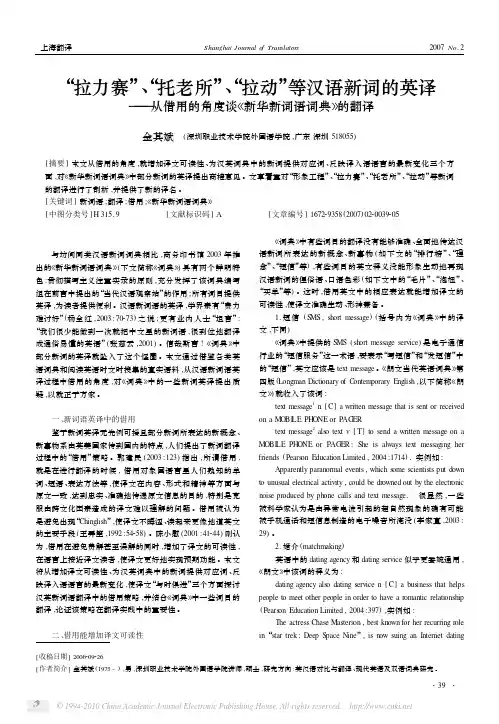
上海翻译Shanghai Journal o f Translator s 2007No .2[收稿日期]2006209226[作者简介]金其斌(1975-),男,深圳职业技术学院外国语学院讲师,硕士,研究方向:英汉语对比与翻译、现代英语及双语词典研究。
“拉力赛”、“托老所”、“拉动”等汉语新词的英译———从借用的角度谈《新华新词语词典》的翻译金其斌 (深圳职业技术学院外国语学院,广东深圳518055)[摘要]本文从借用的角度,就增加译文可读性、为汉英词典中的新词提供对应词、反映译入语语言的最新变化三个方面,对《新华新词语词典》中部分新词的英译提出商榷意见。
文章着重对“形象工程”、“拉力赛”、“托老所”、“拉动”等新词的翻译进行了剖析,并提供了新的译名。
[关键词]新词语;翻译;借用;《新华新词语词典》[中图分类号]H 315.9[文献标识码]A[文章编号]167229358(2007)022******* 与坊间同类汉语新词词典相比,商务印书馆2003年推出的《新华新词语词典》(下文简称《词典》)具有两个鲜明特色:贯彻描写主义注重实录的原则,充分发挥了该词典编写组在前言中提出的“当代汉语观察站”的作用;所有词目提供英译,为读者提供便利。
汉语新词语的英译,学界素有“费力难讨好”(杨全红,2003:70273)之说;更有业内人士“坦言”:“我们很少能做到一次就把中文里的新词语,很到位地翻译成通俗易懂的英语”(张慈云,2001)。
信哉斯言!《词典》中部分新词的英译就坠入了这个怪圈。
本文通过借鉴各类英语词典和阅读英语时文时搜集的真实语料,从汉语新词语英译过程中借用的角度,对《词典》中的一些新词英译提出质疑,以就正于方家。
一、新词语英译中的借用鉴于新词英译无先例可援且部分新词所表达的新概念、新事物系由英美国家传到国内的特点,人们提出了新词翻译过程中的“借用”策略。
郭建民(2003:123)指出,所谓借用,就是在进行翻译的时候,借用对象国语言里人们熟知的单词、短语、表达方法等,使译文在内容、形式和精神等方面与原文一致,达到忠实、准确地传递原文信息的目的,特别是克服由跨文化因素造成的译文难以理解的问题。
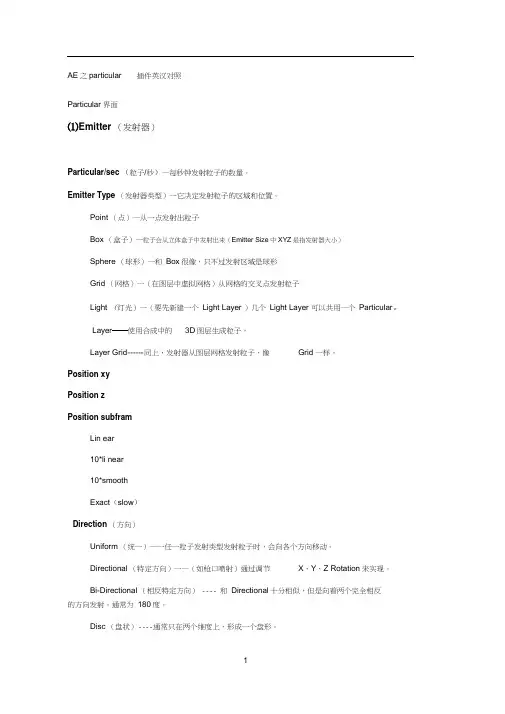
AE之particular 插件英汉对照Particular 界面⑴Emitter (发射器)Particular/sec (粒子/秒)—每秒钟发射粒子的数量。
Emitter Type (发射器类型)一它决定发射粒子的区域和位置。
Point (点)一从一点发射出粒子Box (盒子)一粒子会从立体盒子中发射出来(Emitter Size中XYZ是指发射器大小)Sphere (球形)一和Box很像,只不过发射区域是球形Grid (网格)一(在图层中虚拟网格)从网格的交叉点发射粒子Light (灯光)一(要先新建一个Light Layer )几个Light Layer 可以共用一个Particular。
Layer——使用合成中的3D图层生成粒子,Layer Grid ------ 同上,发射器从图层网格发射粒子,像Grid 一样。
Position xyPosition zPosition subframLin ear10*li near10*smoothExact(slow)Direction (方向)Uniform (统一)一一任一粒子发射类型发射粒子时,会向各个方向移动。
Directional (特定方向)一一(如枪口喷射)通过调节X、Y、Z Rotation来实现。
Bi-Directional (相反特定方向) ---- 和Directional十分相似,但是向着两个完全相反的方向发射。
通常为180度。
Disc (盘状)----通常只在两个维度上,形成一个盘形。
Outwards (远离中心)一粒子会始终向远离发射点的方向移动。
而Uniform是随机的。
Direction Spread (方向拓展)一一可以控制粒子发射方向的区域。
粒子会向整个区域的百分之几运动。
(即粒子发射方向有多宽)Velocity (速度)一一粒子每秒钟运动的像素数。
Velocity Random —每个粒子Velocity的随机性会随机增加或者减小每个粒子的Velocity。
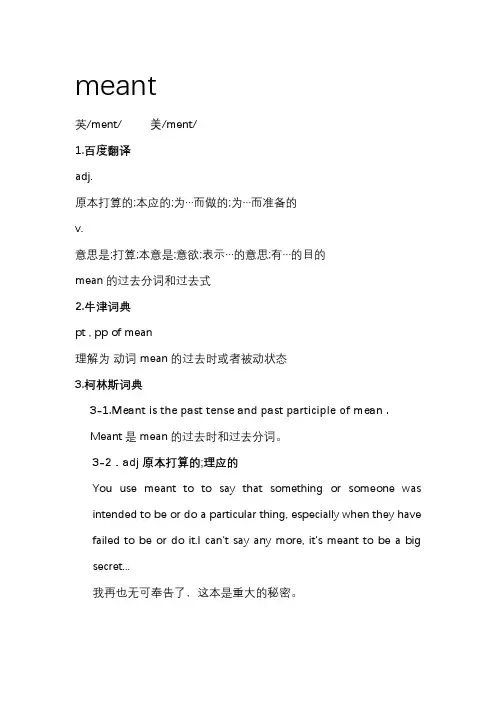
meant
英/ment/ 美/ment/
1.百度翻译
adj.
原本打算的;本应的;为…而做的;为…而准备的
v.
意思是;打算;本意是;意欲;表示…的意思;有…的目的
mean的过去分词和过去式
2.牛津词典
pt , pp of mean
理解为动词 mean的过去时或者被动状态
3.柯林斯词典
3-1.Meant is the past tense and past participle of mean .
Meant是mean的过去时和过去分词。
3-2.adj 原本打算的;理应的
You use meant to to say that something or someone was intended to be or do a particular thing, especially when they have failed to be or do it.I can't say any more, it's meant to be a big secret...
我再也无可奉告了,这本是重大的秘密。
3-3.ADJ 为…而做的;为…而准备的
If something is meant for particular people or for a particular situation, it is intended for those people or for that situation. Fairy tales weren't just meant for children...
童话故事不仅仅是写给孩子们的。
学术综合英语主编罗立胜全文翻译1—8单元南京理工大学 机械工程学院 测试12级研究生整理南京理工大学 机械工程学院 测试12级研究生整理第 20 页,共 44 页 2013-04-18南京理工大学 机械工程学院 测试12级研究生整理第 21 页,共 44 页 2013-04-18南京理工大学 机械工程学院 测试12级研究生整理第 22 页,共 44 页 2013-04-18南京理工大学 机械工程学院 测试12级研究生整理第 23 页,共 44 页 2013-04-18南京理工大学 机械工程学院 测试12级研究生整理第 24 页,共 44 页 2013-04-18南京理工大学 机械工程学院 测试12级研究生整理第 25 页,共 44 页 2013-04-18南京理工大学 机械工程学院 测试12级研究生整理第 28 页,共 44 页 2013-04-18南京理工大学 机械工程学院 测试12级研究生整理第 29 页,共 44 页 2013-04-18南京理工大学 机械工程学院 测试12级研究生整理第 30 页,共 44 页 2013-04-18南京理工大学 机械工程学院 测试12级研究生整理第 31 页,共 44 页 2013-04-18南京理工大学 机械工程学院 测试12级研究生整理第 32 页,共 44 页 2013-04-18南京理工大学 机械工程学院 测试12级研究生整理第 33 页,共 44 页 2013-04-18南京理工大学 机械工程学院 测试12级研究生整理第 34 页,共 44 页 2013-04-18南京理工大学 机械工程学院 测试12级研究生整理第 35 页,共 44 页 2013-04-18南京理工大学 机械工程学院 测试12级研究生整理第 36 页,共 44 页 2013-04-18南京理工大学 机械工程学院 测试12级研究生整理第 37 页,共 44 页 2013-04-18南京理工大学 机械工程学院 测试12级研究生整理第 38 页,共 44 页 2013-04-18南京理工大学 机械工程学院 测试12级研究生整理第 39 页,共 44 页 2013-04-18南京理工大学 机械工程学院 测试12级研究生整理第 40 页,共 44 页 2013-04-18南京理工大学 机械工程学院 测试12级研究生整理第 41 页,共 44 页 2013-04-18南京理工大学 机械工程学院 测试12级研究生整理第 42 页,共 44 页 2013-04-18南京理工大学 机械工程学院 测试12级研究生整理第 44 页,共 44 页 2013-04-18。
particular造句particular造句1、Now it's starting to be used for particular kinds of clergy in the church.现在用来形容教会里,一种神职人员。
2、A section of storage to be used for a particular purpose.仓库中用于特殊目的的部分3、I have nothing particular to say.我没什么特别要说的。
4、This particular oven is used for annealing borosilicate glass.这个特别烘箱是用于退火硼硅玻璃。
5、overlay to show the stars visible at a particular time and place星座一览图天体球的一半或多半在平面图上的极投影图,这种图具有可调节的遮蔽物以显示在给定时刻和位置可见的恒星6、I know of a child who read a particular favourite book until it was in tatters.我认识一个小孩,他把一本特别喜欢的书看得破旧不堪。
7、Do we wish to concentrate on a particular locale or work regionally or globally?我们希望专注于一个具体的地点,还是在某个地区或在全球开展工作?8、The hymns of a particular period or church.某一特定时期或某一教堂的赞歌或赞美诗9、Piece of stone shaped for a particular purpose加工成某形状作某用途的石块10、A set of clothes appropriate for a particular occasion or season.套装适合某一特定场合或季节穿的一套衣服11、I have a particular aversion to fish smell.我对鱼腥味特别反感。
【导语】本文将介绍ae particular world的词汇解释、用法示例及相关知识,帮助读者更好地理解这一词组。
一、ae particular world的中文解释ae particular world可翻译为“一个特定的世界”,其中ae为英文中的一种缩写形式,在特定的语境中代表一个或者一种特殊的概念,而此处引申到一个特定的世界。
二、ae particular world的用法示例1. 此处是ae particular world的用法示例,可以更好地理解这一词组在句子中的意思。
2. 此处是ae particular world的用法示例,可以更好地理解这一词组在句子中的意思。
3. 此处是ae particular world的用法示例,可以更好地理解这一词组在句子中的意思。
三、ae particular world的相关知识1. ae particular world常常出现在文学作品或者诗歌中,代表着作者营造的独特世界观。
2. ae particular world也可以用于描述某种意义上的孤岛,比如某个人的内心世界或者某个小裙体的特殊社区。
3. ae particular world常常代表着某种扭曲、离经叛道的世界观,给人以另类或者异化的感觉。
四、总结通过对ae particular world的词汇解释、用法示例及相关知识的介绍,相信读者对这一词组有了更清晰的认识。
在实际运用中,读者可以根据具体语境更好地理解和运用这一词组,为自己的表达增添新的内涵。
一、ae particular world的深层含义在之前的介绍中,我们了解到ae particular world指的是一个特定的世界,可以是虚构的,也可以是真实的,是作者或个体营造的独特世界观。
然而,ae particular world所蕴含的含义远不止这些。
它通常代表着对真实世界的审视和批判,是对常规世界观的挑战和拓展。
在文学作品中,一些作家会通过构建ae particular world来表达对主流价值观念的反思和批判,突显个体内心世界的独立性和与外部世界的隔阂。
view的中文释义及用法noun●想法opinion1 [C] ~ (about/on sth)(个人的)看法,意见,见解;态度a personal opinion about sth; an attitude towards sth to have different/conflicting/opposing views 有不同的/ 矛盾的/ 相反的观点to have strong political views 持强硬的政治观点Eg:His views on the subject were well known.他对这个问题的看法众所周知。
This evidence supports the view that there is too much violence on television.这一证据对电视节目中暴力太多的观点予以支持。
We take the view that it would be wrong to interfere.我们所持的态度是:干涉是错误的。
In my view it was a waste of time.依我看,这是浪费时间。
What is needed is a frank exchange of views .需要的是坦诚地交换意见。
●see also point of view 理解方式way of understanding2 [sing.] ~ (of sth)(理解或思维的)方法,方式a way of understanding or thinking about sthEg:He has an optimistic view of life.他乐观地看待人生。
the Christian view of the world 基督教的世界观Eg:The traditional view was that marriage was meant to last.传统的观念是结成夫妻就要白头到老。
第一课中东的集市中东的集市仿佛把你带回到了几百年、甚至几千年前的时代。
此时此刻显现在我脑海中的这个中东集市,其入口处是一座古老的砖石结构的哥特式拱门。
你首先要穿过一个赤日耀眼、灼热逼人的大型露天广场,然后走进一个凉爽、幽暗的洞穴。
这市场一直向前延伸,一眼望不到尽头,消失在远处的阴影里。
赶集的人们络绎不绝地进出市场,一些挂着铃铛的小毛驴穿行于这熙熙攘攘的人群中,边走边发出和谐悦耳的叮当叮当的响声。
市场的路面约有十二英尺宽,但每隔几码远就会因为设在路边的小货摊的挤占而变窄;那儿出售的货物各种各样,应有尽有。
你一走进市场,就可以听到摊贩们的叫卖声,赶毛驴的小伙计和脚夫们大着嗓门叫人让道的吆喝声,还有那些想买东西的人们与摊主讨价还价的争吵声。
各种各样的噪声此伏彼起,不绝于耳,简直叫人头晕。
随后,当往市场深处走去时,人口处的喧闹声渐渐消失,眼前便是清静的布市了。
这里的泥土地面,被无数双脚板踩踏得硬邦邦的,人走在上面几乎听不到脚步声了,而拱形的泥砖屋顶和墙壁也难得产生什么回音效果。
布店的店主们一个个都是轻声轻气、慢条斯理的样子;买布的顾客们在这种沉闷压抑的气氛感染下,自然而然地也学着店主们的榜样,变得低声细语起来。
中东集市的特点之一是经销同类商品的店家,为避免相互间的竞争,不是分散在集市各处,而是都集中在一块儿,这样既便于让买主知道上哪儿找他们,同时他们自己也可以紧密地联合起来,结成同盟,以便保护自己不受欺侮和刁难。
例如,在布市上,所有那1些卖衣料、窗帘布、椅套布等的商贩都把货摊一个接一个地排设在马路两边,每一个店铺门面前都摆有一张陈列商品的搁板桌和一些存放货物的货架。
讨价还价是人们习以为常的事。
头戴面纱的妇女们迈着悠闲的步子从一个店铺逛到另一个店铺,一边挑选一边问价;在她们缩小选择范围并开始正儿八经杀价之前,往往总要先同店主谈论几句,探探价底。
对于顾客来说,至关重要的一点是,不到最后一刻是不能让店主猜到她心里究竟中意哪样东西、想买哪样东西的。
上海翻译Shanghai Journal o f Translator s 2007No .2[收稿日期]2006209226[作者简介]金其斌(1975-),男,深圳职业技术学院外国语学院讲师,硕士,研究方向:英汉语对比与翻译、现代英语及双语词典研究。
“拉力赛”、“托老所”、“拉动”等汉语新词的英译———从借用的角度谈《新华新词语词典》的翻译金其斌 (深圳职业技术学院外国语学院,广东深圳518055)[摘要]本文从借用的角度,就增加译文可读性、为汉英词典中的新词提供对应词、反映译入语语言的最新变化三个方面,对《新华新词语词典》中部分新词的英译提出商榷意见。
文章着重对“形象工程”、“拉力赛”、“托老所”、“拉动”等新词的翻译进行了剖析,并提供了新的译名。
[关键词]新词语;翻译;借用;《新华新词语词典》[中图分类号]H 315.9[文献标识码]A[文章编号]167229358(2007)022******* 与坊间同类汉语新词词典相比,商务印书馆2003年推出的《新华新词语词典》(下文简称《词典》)具有两个鲜明特色:贯彻描写主义注重实录的原则,充分发挥了该词典编写组在前言中提出的“当代汉语观察站”的作用;所有词目提供英译,为读者提供便利。
汉语新词语的英译,学界素有“费力难讨好”(杨全红,2003:70273)之说;更有业内人士“坦言”:“我们很少能做到一次就把中文里的新词语,很到位地翻译成通俗易懂的英语”(张慈云,2001)。
信哉斯言!《词典》中部分新词的英译就坠入了这个怪圈。
本文通过借鉴各类英语词典和阅读英语时文时搜集的真实语料,从汉语新词语英译过程中借用的角度,对《词典》中的一些新词英译提出质疑,以就正于方家。
一、新词语英译中的借用鉴于新词英译无先例可援且部分新词所表达的新概念、新事物系由英美国家传到国内的特点,人们提出了新词翻译过程中的“借用”策略。
郭建民(2003:123)指出,所谓借用,就是在进行翻译的时候,借用对象国语言里人们熟知的单词、短语、表达方法等,使译文在内容、形式和精神等方面与原文一致,达到忠实、准确地传递原文信息的目的,特别是克服由跨文化因素造成的译文难以理解的问题。
AE之particular插件英汉对照Particular界面(1)Emitter(发射器)Particular/sec(粒子/秒)—每秒钟发射粒子的数量。
Emitter Type(发射器类型)—它决定发射粒子的区域和位置。
Point(点)—从一点发射出粒子Box(盒子)—粒子会从立体盒子中发射出来(Emitter Size中XYZ是指发射器大小)Sphere(球形)—和Box很像,只不过发射区域是球形Grid(网格)—(在图层中虚拟网格)从网格的交叉点发射粒子Light(灯光)—(要先新建一个Light Layer)几个Light Layer可以共用一个Particular。
Layer——使用合成中的3D图层生成粒子,Layer Grid——同上,发射器从图层网格发射粒子,像Grid一样。
Position xyPosition zPosition subframLinear10*linear10*smoothExact(slow)Direction(方向)Uniform(统一)——任一粒子发射类型发射粒子时,会向各个方向移动。
Directional(特定方向)——(如枪口喷射)通过调节X、Y、Z Rotation来实现。
Bi-Directional(相反特定方向)——和Directional十分相似,但是向着两个完全相反的方向发射。
通常为180度。
Disc(盘状)——通常只在两个维度上,形成一个盘形。
Outwards(远离中心)—粒子会始终向远离发射点的方向移动。
而Uniform是随机的。
Direction Spread(方向拓展)——可以控制粒子发射方向的区域。
粒子会向整个区域的百分之几运动。
(即粒子发射方向有多宽)Velocity(速度)——粒子每秒钟运动的像素数。
Velocity Random—每个粒子Velocity的随机性会随机增加或者减小每个粒子的Velocity。
Velocity Distribution(速度分布)Velocity from Motion(速度跟随运动)—粒子在向外运动的同时也会跟随发射器的运动方向运动。
Layer Emitter(图层发射器)Layer(选用哪一个图层作为发射器)Layer Sampling(图层采样)Current Time(当前时间)Particular Birth Time(粒子生成时间)Layer RGB Usage(图层颜色使用方式)Lightness-Size——随着图像的明暗变化,粒子的大小也跟着变化Lightness-Velocity——随着图像的明暗变化,粒子的速度也跟着变化Lightness-Rotation——随着图像的明暗变化,粒子的旋转也跟着变化RGB-Size,Vel,Rot——随着图像的颜色变化,粒子的大小,速度,旋转同时变化RGB-Particle Color——随着图像的颜色变化,粒子的颜色也跟着变化Grid Emitter(网格发射器)Particular in X(粒子在X方向上的数量)Particular in Y(粒子在Y方向上的数量)Particular in Z(粒子在Z方向上的数量)Type(类型)Periodic Burst(周期性爆炸)——粒子同时发射出来Traverse(横渡)——粒子以行的形式依次发射出来Emission ExtrasPre Run(提前运行)Perodicity Rndlights unique seedsRandom Seed(随机性)——随即数值的开始点,它一变整个插件的随机性都会变化(2)Particle(粒子)Life[sec]——实际上就是粒子生存的时间。
Life Random——随机增加或者减少粒子的生命Particle Type(粒子类型)Sphere——是使用2D的球形图片作为粒子Glow Sphere(NO DOF)—同上,粒子加强型。
(NO DOF)意思是这些粒子没有景深效果Star(NO DOF)——四角形形状Cloudlet——如同一堆羽毛当作一个粒子。
Streaklet(条状痕)——由几个粒子组成统一的一组形状。
Sprite(子画面)——可以使用任何图层作为粒子,甚至在一个发射器中应用多种粒子类型。
都允许在Particular中使用AE的图层作为粒子。
Sprite Colorize—仅将图层的形状和材质与粒子交换,颜色并没有交换,但可以调节。
Sprite Fill——仅仅将图层的形状与粒子交换,颜色依旧是粒子的颜色。
Sphere Feather(球形羽化)——控制粒子的羽化程度及透明度Textured polygon多边形机理贴图Textured polygon colorize多边形贴图颜色替换Textured polygon fill多边形贴图填充Texture(纹理)——与Sprite(子画面)相匹配的选项Layer——选择要替换粒子的图层Time Sampling(时间采样)——时间采样的类型(1)Start at Birth–Play Once从头开始播放custom层粒子一次。
(2)Start at Birth–Loop循环播放custom层粒子。
(3)Start at Birth–Stretch延伸播放,匹配粒子的生命周期。
(4)Random–Still Frame随机抓取custom层中的一帧作为粒子(5)Random–Play Once随机抓取custom层中的一帧作为播放起始点,然后按照正常的速度进行播放custom层。
(6)Random–Loop随机抓取custom层中的一帧作为播放起始点,然后循环播放custom层。
(7)Split Clip–Play Once随机抽取custom层中的一个片断(clip)作为粒子,并且只播放一次。
(8)Split Clip–Loop随机抽取custom层中的一个片断(clip)作为粒子,并进行循环播放。
(9)Split Clip–Stretch随机抽取custom层中的一个片断,并进行时间延伸,以匹配粒子的生命周期。
Current Frame-Freeze Random Seed(随机性)Number of Clips(分离的个数)——将粒子分成几份Subframe Sampling(子帧取样)Rotation(旋转)Rotation——调整粒子旋转角度Random Rotation——随机增加或减少旋转角度Rotation Speed——粒子随着时间转动,数值表示每秒旋转的圈数Size——粒子出生时的大小Size Random——增加粒子大小的随机性Size over Life——可以控制每个粒子的大小随时间的变化。
Y轴代表粒子的大小,X轴代表粒子从出生到死亡的时间Opacity(不透明度)——作用原理同SizeOpacity Random——增加粒子不透明度的随机性Opacity over Life——不透明度随着时间变化Set Color(设置粒子颜色)At Birth——设置粒子出生时的颜色Over Life——颜色随时间变化,通过下面的Color over Life调节Random from Gradient——从渐变中随机生成,是Color over Life中的颜色随机的Color Random——随机改变色相Color over Life——颜色随时间变化Transfer Mode—控制当粒子重叠时颜色的混合方式Add——叠加颜色(变亮)Screen或者Lighten——Normal/Add over Life——Add模式随时间变化Normal/Screen over Life——Screen模式随时间变化Glow(辉光)Transfer Mode——Glow与粒子的叠加模式Streaklet(条状痕)Random Seed(随机性)No Streaks(条痕数)——条状痕由几个粒子组成Streak Size(条痕大小)(3)Shading(阴影)——粒子制造阴影效果,具有立体感Shading(阴影开关)Light Falloff(光衰减开关)Nominal Distance(额定距离)Ambient(环境)Diffuse(漫反射)Specular Amount(镜面反射程度)Specular Sharpness(镜面反射清晰度)Shadowlet for Main(主粒子阴影开关)Shadowlet for Aux(子粒子阴影开关)(4)Physics(物理)Physics Model(物理模式)Air(空气)Bounce(碰撞)Gravity(重力)Physics Time Factor(现实时间控制器)——默认值是1(表示时间和现实相同),0(表示冻结时间),2(表示正常速度的两倍)-1(时间倒流)该参数可以控制粒子在整个生命周期中的运动情况,可以使粒子加速或减速,也可以冻结或返回等Air(空气)Motion Path(运动路径)——粒子跟随光源运动的设置。
HQ表示光滑。
一个Particular 只能使用一个Motion Path,可以在一个comp中有最多9个Motion Path。
Air Resistance(空气阻力)Air Resistance Rotation(空气阻力旋转)Spin Amplitude(旋转幅度)Spin Frequency(旋转频率)Fade-in Spin[sec](在自旋中淡出的时间)Wind X(X方向的风)Wind Y(Y方向的风)Wind Z(Z方向的风)Visualize Fields(可视化领域)——会出现红蓝垂直线,移动中心点,可以观察粒子空间状态。
Turbulence Field(紊乱场)——影响物理因素本有的稳定性质,粒子系统中的干扰,以一种特殊的方式为每个粒子赋予一个随机的运动速度Affect Size——影响粒子大小Affect Position——影响粒子位置Fade-in Time[sec](淡出时间)设置粒子受干扰场影响前的时间。
Fade-in Curve(在曲线中褪色方式)Scale设置不规则碎片图形(fractal)的放大陪数。
Complexity(复杂程度)设置产生不规则碎片图形(fractal)的叠加层次,值越大细部特征载明显。
Octave Multiplier(倍频倍增器)设置干扰场叠加在前一时刻干扰场的影响程度(影响系数)。
值越大,干扰场对粒子的影响越大,粒子属性的变化越明显。
Octave Scale(倍频比例)设置干扰场叠加在前一时刻干扰场的放大陪数。
Evolution Speed(演变速度)Evolution Offset(演变偏移)X Offset(X轴偏移)Y Offset(Y轴偏移)Z Offset(Z轴偏移)Move with Wind(随风移动)Spherical Field(球形区域)——定义一个区域,在这个区域粒子不会进入或者把粒子排斥出这个区域Strength(强度)Position XY&Z设置场的位置属性。